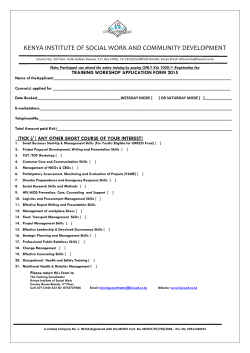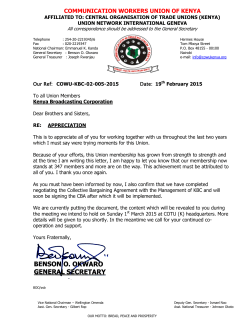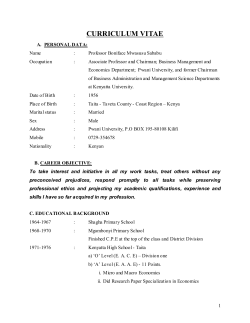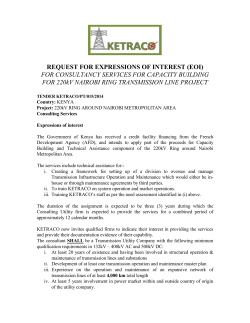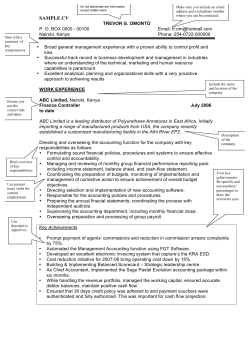
i Effect of Business Value Chain Practices on the Supply Chain
Effect of Business Value Chain Practices on the Supply Chain Performance of Large Manufacturing Firms in Kenya TITLE Perris Wambui Chege A Research Proposal Submitted in Partial Fulfillment of Requirement for the Doctor of Philosophy Degree in Supply Chain Management of Jomo Kenyatta University of Agriculture and Technology. 2014 i DECLARATION This research proposal is my original work and has not been presented for a degree in any other university or for any other award. Signature……………………………… Date………………………… Perris Wambui Chege HD411-2556/2010 This research proposal has been submitted for examination with our approval as university supervisors. Signature……………………… Date ……………………….. Dr. Patrick Karanja Ngugi JKUAT, Kenya Date………………………… Signature……………………… Dr. John Karanja Ngugi Kenyatta University, Kenya ii DEDICATION This research proposal is dedicated to my Parents, my spouse George, my daughters Chelsea and Virginia and my son Victor and all my friends for their support and encouragement. God bless you all. iii ACKNOWLEDGEMENTS In all ways this work could not have been accomplished had it not for God’s grace .It all started with a simple prayer and a step of faith. I thank him for accomplishing the good work he started in me. I wish to acknowledge and thank my supervisors Dr. Karanja Patrick and Dr. Karanja Ngugi for their constant guidance in ensuring that in deed this work is of the required standard .Thank you for helping me achieve my dream. I express my special thanks to my Dad Chege, sister Pesh, brothers Dave, Bidan and John for having been at my side all along, and for according all kind of support that I needed. A special word of gratitude goes to George and our beautiful children Chelsea, Virginia and Victor. Thanks for allowing me to study during what you considered to be odd hours and times especially at the initial times of my studies. My sincere appreciation goes to my colleagues both at Kenyatta University and Jomo Kenyatta University of Agriculture and Technology for their concern, support and encouragement to forge ahead. Always ready to answer the many questions I asked in my bid to make this work make a contribution to knowledge and the business world. God bless you iv TABLE OF CONTENTS DECLARATION............................................................................................................... ii DEDICATION…………………………………………………………………………..iii ACKNOWLEDGEMENTS ............................................................................................ iv LIST OF FIGURES ........................................................................................................ vii LIST OF TABLES ......................................................................................................... viii ABBREVIATIONS AND ACRONYMS ........................................................................ ix OPERATIONAL DEFINATION OF TERMS……………………………………….xi ABSTRACT .................................................................................................................... xiv CHAPTER ONE………………………………………………………………………..1 INTRODUCTION............................................................................................................. 1 1.1 Background of the Study .......................................................................................... 1 1.2 Statement of the Problem ........................................................................................ 13 1.3 Study Objectives .................................................................................................... 14 1.4 Hypotheses ............................................................................................................. 15 1.5 Significance of the study........................................................................................ 15 1.6 Scope of the Study ................................................................................................. 16 1.7 Limitations of the Study ........................................................................................ 16 CHAPTER TWO ............................................................................................................ 18 LITERATURE REVIEW .............................................................................................. 18 2.1 Introduction ............................................................................................................. 18 2.2 Theoretical Framework ........................................................................................... 18 v 2.3 Conceptual Framework ........................................................................................... 35 2.4 Empirical literature ................................................................................................. 42 2.5 Critique of empirical literature ............................................................................... 56 2.6 Research Gaps......................................................................................................... 57 CHAPTER THREE: ....................................................................................................... 59 RESEARCH METHODOLOGY .................................................................................. 59 3.1 Introduction ............................................................................................................. 59 3.2 Research Design ..................................................................................................... 59 3.3 Population ............................................................................................................... 61 3.4 Sample and sampling technique ............................................................................. 62 3.5 Data Collection Procedures ................................................................................... 63 3.6 Pilot study ............................................................................................................... 64 3.7 Data collection instrument ...................................................................................... 66 3.8 Data analysis .......................................................................................................... 67 3.9 Ethical considerations……………………………………………………………..72 REFERENCES ................................................................................................................ 73 APPENDICES…………………………………………………………………………. 88 Appendix i: Introductory Letter ....................................................................................... 88 Appendix ii: Questionnaire .............................................................................................. 89 Appendix iii: List of the Manufacturing firms in Kenya .................................................. 93 Appendix iv: Work Plan……………………………………………………….................99 Appendix v: Budget……………………………………………………………………..100 Appendix vi: Summary of empirical Literature…………………………………………101 vi LIST OF FIGURES Figure 2.1 Porters Generic Value Chain…………………………………………... 22 Figure 2.2 Conceptual Framework………………………………………………... vii 33 LIST OF TABLES Table 3.1 Population ……..…………………............................................................ 51 Table 3.2 Operationalisation and measurement of variables………………………. viii 58 ABBREVIATIONS AND ACRONYMS BSC Balance Score Card CDF Cumulative Density Function CEO Chief Executive Officer CRM Customer Relationship Management COMESA Common Market for East and Southern Africa eSCM Electronic Supply Chain Management EAC East Africa Community ERP Enterprise Resource Planning GDP Gross Domestic Product GOK Government Of Kenya ICT Information and Communication Technology IT Information Technology JIT Just in Time JKUAT Jomo Kenyatta University of Agriculture and Technology KAM Kenya Association of Manufacturers LTD Limited NACOSTI National Council for Research and Technology OECD Organisation for Economic Co-operation and Development PM Process Management PMG Performance Measurement Group SC Supply Chain SCC Supply Chain Council SCM Supply Chain Management SCOR Supply Chain Operations Reference ix SPSS Statistic Package for Social Sciences SRM Supplier Relationship Management TQM Total Quality Management UK United Kingdom US United States USAID United States Agency for International Development VCM Value Chain Management WTO World Trade Organization x OPERATIONAL DEFINITION OF TERMS Business Value chain: Is a linear map of the way in which value is added by means of process from raw materials to finished products including service after delivery within an organization (Lysons, 2008). Is includes inbound logistics, operations, outbound logistics, sales and marketing and services. Business Value Chain practices: A set of activities undertaken in an organization to promote effective management of its value chain (Morris, 2012).They include supplier relationship management (SRM), Process management (PM), Customer relationship management and value chain support practices. Supply chain performance (SCP): This is the process of qualifying the efficiency and effectiveness of the supply chain (iIkka, 2012). It constitutes five attributes of SC performance which are SC reliability, SC responsiveness, SC flexibility, SC costs and SC asset management. Large Manufacturing sector: These are value-adding industries in Kenya that are registered members of Kenya Manufactures’ Association (KAM, 2014) and are large in size compared to others in their specific sector. xi Supplier relationship management (SRM) :The discipline of strategically planning for, and managing, all interactions with third party organizations that supply goods and/or services to an organization in order to maximize the value of those interactions. It involves Information sharing, supplier development, collaborative initiatives, Supplier performance and supplier selection (Diana, 2011). Process management (PM) :Application of knowledge, skills, tools, techniques and systems to define, visualize, measure, control, report and improve processes with the goal to meet customer requirements profitably. It involves control of processes, value chain map, identification of core competences, sustainable processes, identification of cost drivers, quality assurance (Ponsignon, Maull & Smart, 2013) Customer relationship management (CRM): Entails all aspects of interaction that a company has with a customer, whether it is sales or service-related. It involves customer interaction, ensuring Customer satisfaction, knowledge of Customer expectations and responding to customer demands (Diana, 2011). Information Technology (IT) support practices: An integrated set of components for collecting, storing, processing, and communicating information that gives IT the capability to support value chain primary activities in the entire organization. This includes management support, supply chain processes support, procurement support, operations support and CRM support (Peter, Kevin, Marcos & Marcelo, 2010) xii ABSTRACT The manufacturing sector in Kenya constitutes 70 per cent of the industrial sector contribution to GDP, with building, construction, mining and quarrying cumulatively contributing the remaining 30 per cent. However statistics show that the contribution of the manufacturing sector to GDP has continued to stagnate at about 10 %, with contribution to wage employment on a declining trend. Statistics also indicate that Kenya’s share of manufacturing exports in her total merchandise exports is low (only 35%) compared to aspirator countries such as South Africa (47%), Malaysia (67%) and Singapore (73%). In the modern world, competition is no longer among organizations, but among supply chains. Therefore poor performance can be attributed to the fact that Kenya’s manufacturing sector supply chains has continued to lag behind in terms of value addition as reported in a recent Kenya Economic Report. Previous studies in the developing and developed economies show that adopting best practices in business value chain is a powerful tool for implementing value addition strategies in the supply chains hence better supply chain performance. The general objective of this study is to investigate the effect of business value chain practices on the supply chain performance of the large private manufacturing firms in Kenya. The specific objectives will be to; assess the influence of supplier relationship management on the supply chain performance of the listed manufacturing firms in Kenya; determine if process management affect supply chain performance of the large manufacturing firms in Kenya ; find out if customer relationship management influence supply chain performance of the large manufacturing firms in Kenya ; establish if support practices affect supply chain performance of the large manufacturing firms in Kenya.Cross sectional– descriptive research design will be used to conduct this study. Stratified sampling will be done to arrive at a representative sample of the large manufacturing firms in Kenya. Primary data will be collected using questionnaires which will be dropped and picked later. A pilot study will be conducted to test validity of the questionnaire and cronbanch alpha will be utilized in testing its reliability. Diagnosis of the model will be done using the Wald chi-square, Cox and Snell and Nagelkerke tests to ascertain whether it is fit for further analysis. Further the degree to which predicted probabilities agree with actual outcomes will be expressed as a classification table. A Logistic regression model will be used to analyze the objectives of the study. Content analysis will be used to analyze qualitative data. Results of the data analysis will be presented using tables and inferential statistics to explain the relationship between the variables. The study will be of use to management of organizations within the manufacturing sector, the policy makers, and other researchers. xiii
© Copyright 2025
